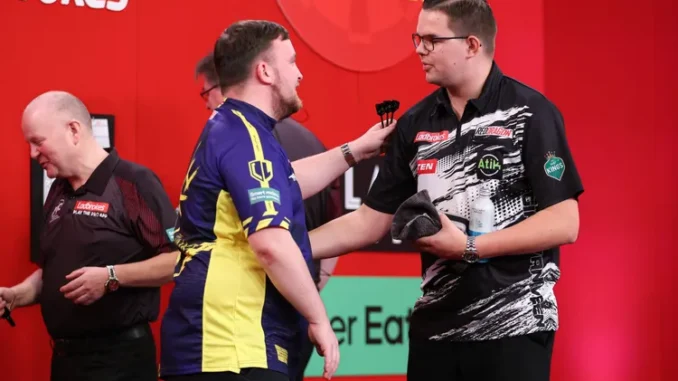
The electric buzz of the darts world is palpable as the World Grand Prix descends upon Leicester’s Morningside Arena, transforming the city into a cauldron of flying arrows and fervent cheers. This iconic double-in, double-out spectacle, where every leg begins and ends with precision strikes on the outer ring, has long been a proving ground for the sport’s elite. For two nights, the arena will pulse with the drama of 32 players vying for glory in a £600,000 prize pot, but few matchups ignite as much intrigue as the opening-round showdown between teenage sensation Luke Littler and the towering Dutch powerhouse Gian van Veen. It’s a collision course that could rewrite the tournament’s narrative before the first dart even whistles through the air.
Littler, the 18-year-old prodigy often hailed as the future—and perhaps the present—of professional darts, enters the fray with a trophy cabinet that defies his youth. Fresh off a string of major triumphs, including a commanding UK Open victory earlier this year, “The Nuke” has averaged scores that leave opponents in awe. His blistering 107.3 average against van Veen during that UK Open run was a statement of intent, a demolition that propelled him to the title. Yet, for all his dominance, Littler carries the scars of last year’s debut here: a heartbreaking first-round exit to Rob Cross, where the format’s unforgiving demands exposed even his prodigious talent. This time, he’s back with a year’s wisdom under his belt, eyes locked on banishing those ghosts and etching his name deeper into the event’s storied history.
Standing in his path is van Veen, the 23-year-old Dutch sensation known as “The Giant” for his imposing 6’7″ frame and equally outsized game. Van Veen, seeded as the top qualifier outside the elite top 16, has been on a tear in 2025, blending raw power with surgical finishing. His arsenal—centered around deadly double 16s and bullseyes—has felled giants before, and his recent form screams danger. Just last month, he unleashed a monstrous 110-plus average in the German Darts Grand Prix, and in their most recent clash at the Czech Darts Open, he edged Littler 6-4 in a thriller that underscored his growing menace. Head-to-head, van Veen holds a narrow 4-3 edge, a statistic that adds layers of psychological warfare to what will be their first-ever encounter under double-start rules.
Darts pundit Paul Nicholson, a former pro with a keen eye for the game’s undercurrents, can’t contain his enthusiasm for this pairing. Speaking ahead of the second night’s action, he painted a vivid picture of the potential chaos. “I love this game for more than one reason because the head-to-head record states that Gian van Veen is 4-3 up,” Nicholson enthused. “They’ve never played double start. Van Veen is a good finisher, he is a double 16 and a bullseye guy. If he gets bulls at the end of legs, Littler could be in trouble.” It’s a warning shot that resonates deeply in a tournament where finishing prowess can turn the tide in an instant. Van Veen’s affinity for those high-value checkouts could exploit any early wobbles from Littler, forcing the youngster into a high-stakes chase from the outset.
Nicholson doesn’t stop at the threat; he sees untapped potential in van Veen to go all the way. Drawing parallels to last year’s surprise package, he mused, “If he can get into double-start darts that De Decker did last year, who knows what he could do.” Indeed, the Dutchman’s trajectory mirrors that of emerging stars who thrive in this format’s pressure cooker. Qualifying as the outsider many feared, van Veen arrives unburdened by seed expectations. “He’s the top qualifier of the players outside the top 16, so he’s the one everybody did not want to get,” Nicholson added, dismissing other contenders like Nathan Aspinall as almost “seeded” in their own right. “Take Aspinall out of it because he feels like a seed anyway, but if you did not want to get someone it would have been van Veen.” For Littler, who might reflect on last year’s stumbles and wonder, “What pressure’s on me?” this is no gentle reintroduction—it’s a trial by fire.
The broader tournament landscape only amplifies the stakes. World number one Luke Humphries, Littler’s partner-in-dominance over the past year, faces his own gauntlet against Aspinall, the Stockport thrower whose explosive scoring has him primed for an upset. Together, Littler and Humphries have hoovered up majors like vacuum cleaners, but the double-in format levels the playing field, rewarding those who master the rhythm of starts and checkouts over sheer averaging brilliance. Co-host Michael Bridge captured the event’s seductive unpredictability: “You could see the top two then easily both going out. I don’t mean to be negative but that is the beauty of the tournament.” Nicholson echoed the sentiment with a grin: “Wouldn’t be shocked if both go out, wouldn’t be shocked if both go through.” In a field boasting six-time World Grand Prix king Michael van Gerwen, defending champion Mike De Decker, and dark horses like Josh Rock and Peter Wright, the Leicester lights could witness coronation or carnage.
As the arrows fly on October 7th, the Morningside Arena will thrum with 3,000 voices, a sea of flags and chants fueling the frenzy. For van Veen, this is a chance to cement his arrival among the immortals; for Littler, a pivotal step in building an unbreakable legacy. Their duel isn’t just a match—it’s a microcosm of darts’ enduring allure: where prodigies meet predators, and one bullseye can shatter empires. Whichever way the legs fall, expect sparks, stories, and perhaps a seismic shift in the world order. In the grand theatre of the oche, trouble brews—and it’s Littler’s to navigate.
Leave a Reply